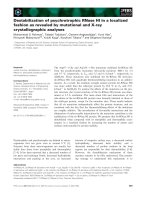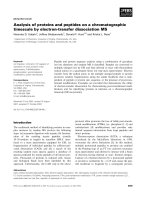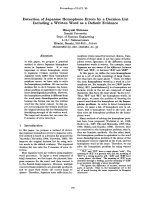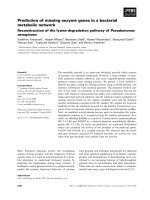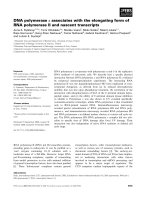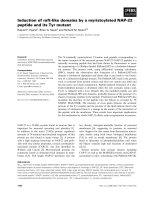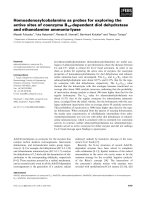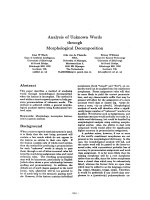Báo cáo khoa học: Interactions of imidazoline ligands with the active site of purified monoamine oxidase A potx
Bạn đang xem bản rút gọn của tài liệu. Xem và tải ngay bản đầy đủ của tài liệu tại đây (495.2 KB, 9 trang )
Interactions of imidazoline ligands with the active site of
purified monoamine oxidase A
Tadeusz Z. E. Jones
1
, Laura Giurato
2
, Salvatore Guccione
2
and Rona R. Ramsay
1
1 Centre for Biomolecular Sciences, University of St Andrews, North Haugh, St Andrews, UK
2 Dipartimento di Scienze Farmaceutiche, Facolta
`
di Farmacia, Universita
`
degli Studi di Catania, Ed. 2 Citta
`
Universitaria, Catania, Italy
In 1984, Bousquet et al. [1] found that clonidine pro-
duced a pharmacologic response, independent of
a-adrenoceptors, at high-affinity imidazoline-binding
sites. These binding sites were later classified into three
different subtypes, and some progress was made in
determining their identity and function [2,3]. Ligands
to the type 2 binding sites (I
2
BS) [4] also inhibit
monoamine oxidase (MAO) but with lower affinity [5].
Some MAO substrates and inhibitors bind to I
2
BS [6].
Harmane, a b-carboline formed from tryptamine, has
nanomolar affinity both for I
2
BS and for MAO, and
mimics the hypotensive effect of clonidine [7]. How-
ever, a careful study using b-carboline derivatives
showed no correlation between MAO-A inhibition and
binding to either high- or low-affinity I
2
BS [8].
Both MAO and I
2
BS are located on the outer mit-
ochondrial membrane [9] and show coexpression dur-
ing the aging process in humans [10]. The protein
labeled by I
2
BS ligands has a similar molecular weight
and peptide sequence to MAO [6,11]. Transfection of
yeast cells with MAO led to the expression of imidazo-
line-binding sites not previously observed, although the
correlation between the number of binding sites and
MAO activity was poor [6,12]. However, a decrease in
the number of I
2
BS in suicide victims was not accom-
panied by a decrease in MAO-B [13]. Furthermore,
MAO-A knockout mice did not lose the high-affinity
imidazoline binding, although a peptide ( 60 kDa)
was no longer labeled by the covalent imidazoline
ligand [14]. At the protein level, photoaffinity labeling
Keywords
docking; I
2
binding sites; imidazoline;
kinetics; monoamine oxidase
Correspondence
R. R. Ramsay, Centre for Biomolecular
Sciences, University of St Andrews, North
Haugh, St Andrews, Fife KY16 9ST, UK
Fax: +44 1334 463400
Tel: +44 1334 463411
E-mail:
(Received 26 September 2006, revised 15
January 2007, accepted 17 January 2007)
doi:10.1111/j.1742-4658.2007.05704.x
The two forms of monoamine oxidase, monoamine oxidase A and mono-
amine oxidase B, have been associated with imidazoline-binding sites (type
2). Imidazoline ligands saturate the imidazoline-binding sites at nanomolar
concentrations, but inhibit monoamine oxidase activity only at micromolar
concentrations, suggesting two different binding sites [Ozaita A, Olmos G,
Boronat MA, Lizcano JM, Unzeta M & Garcı
´
a-Sevilla JA (1997) Br J
Pharmacol 121, 901–912]. When purified human monoamine oxidase A was
used to examine the interaction with the active site, inhibition by guana-
benz, 2-(2-benzofuranyl)-2-imidazoline and idazoxan was competitive with
kynuramine as substrate, giving K
i
values of 3 lm,26lm and 125 lm,
respectively. Titration of monoamine oxidase A with imidazoline ligands
induced spectral changes that were used to measure the binding affinities
for guanabenz (19.3 ± 3.9 lm) and 2-(2-benzofuranyl)-2-imidazoline
(49 ± 8 lm). Only one type of binding site was detected. Agmatine, a
putative endogenous ligand for some imidazoline sites, reduced monoamine
oxidase A under anaerobic conditions, indicating that it binds close to the
flavin in the active site. Flexible docking studies revealed multiple orienta-
tions within the large active site, including orientations close to the flavin
that would allow oxidation of agmatine.
Abbreviations
2-BFI, 2-(2-benzofuranyl)-2-imidazoline; I
2
BS, imidazoline-binding site (type 2); MAO, monoamine oxidase; MPTP, 1-methyl-4-phenyl-1,2,3,6-
tetrahydropyridine.
FEBS Journal 274 (2007) 1567–1575 ª 2007 The Authors Journal compilation ª 2007 FEBS 1567
of the imidazoline site on MAO-B identified a labeled
peptide containing amino acids 149–222 of the MAO-B
sequence [12]. The crystal structure of MAO-B shows
that some of the residues in this peptide lie between
the entrance cavity and the active site [15]. On the
other hand, inhibition of MAO with a mechanism-
based irreversible inhibitor did not prevent binding of
the I
2
ligand 2-(2-benzofuranyl)-2-imidazoline (2-BFI),
suggesting that the I
2
BS was not the active site of
MAO [16].
Imidazolines reversibly inhibit MAO, but with IC
50
or K
i
values in the micromolar range [5,6,17–20].
Examples of the literature values for MAO inhibition
measured in membranous samples with the ligands
used in this study are included in Table 1. It has been
proposed that I
2
BS ligands bind both to the MAO act-
ive site, thereby inhibiting the enzyme, and to a second
site with substantially higher affinity present on a sub-
population of MAO-B enzymes [21]. Recently, some
imidazole derivatives were reported to have high I
2
BS
affinity but negligible MAO inhibitory activity [22],
reinforcing a separate identity of the I
2
BS from the
MAO active site.
The kinetics of MAO inhibition by imidazolines
have been described as noncompetitive [6,20], noncom-
petitive and mixed [17], or competitive for MAO-A
inhibition and mixed for MAO-B inhibition [5]. This
study examines binding of the imidazoline ligands to
purified enzyme of a single subtype (MAO-A) to
characterize their active site binding and the resulting
inhibition. The use of purified enzyme simplifies the
system for kinetics and also allows observation of the
spectrum of the flavin cofactor in MAO-A. The subtle
changes in the flavin spectrum on ligand binding in the
active site [23,24] are concentration-dependent and
saturable, permitting calculation of the dissociation
constant for binding to the active site of MAO-A. To
complement these two methods, flexible docking [25]
was used to visualize the interactions between imidazo-
lines and the MAO-A active site.
Results
Kinetics of inhibition
Guanabenz, 2-BFI and idazoxan all act as inhibitors
of MAO-A, but no inhibition was seen below 0.1 lm
(Fig. 1). Reported K
D
values for I
2
BS vary consider-
ably [5,6,18,19,26], but all indicate much more than
50% occupancy of the I
2
BS at 0.1 lm. There was also
no activation of MAO-A by any ligand, either with
kynuramine (Fig. 1) or with 1-methyl-4-phenyl-1,2,3,6-
tetrahydropyridine (MPTP) (not shown) as a sub-
strate, in contrast to the activation by imidazolines of
benzylamine oxidation catalyzed by bovine plasma
semicarbazide-sensitive amine oxidase [27]. Allosteric
activation of semicarbazide-sensitive amine oxidase by
imidazolines was seen only with selected substrates, so
both kynuramine and MPTP were tested for MAO-A.
As some MAO-A inhibitors (such as the b-carbolines
[28], also known to bind to both I
2
BS and MAO-A [8])
are time-dependent, the time dependence of inhibition
was investigated. For 2-BFI, the inhibition immediately
upon mixing was 40 ± 3% (n ¼ 3). When 2-BFI was
incubated with the enzyme in the cuvette before addi-
tion of substrate, the inhibition was 37 ± 5% (n ¼ 4)
after either 1 min or 5 min of preincubation. A similar
lack of any time-dependent increase in inhibition was
found for the other two inhibitors. Thus, there is no
tighter, time-dependent binding that might account for
the discrepancy between the reported affinities for the
I
2
BS and the MAO-A active site.
Table 1. Binding and inhibition constants for I
2
ligands with MAO-A.
The K
i
values for purified human MAO-A were determined as des-
cribed in Experimental procedures. The K
D
values for human MAO-A
were calculated from the absorbance change at 500 nm induced by
ligand binding (from two experiments for guanabenz and one for
2-BFI and idazoxan, each with 14–18 points). The literature values for
inhibition of MAO-A were measured in membranes from rat liver.
ND, not determined.
Ligand
This work Literature values
K
i
(lM)
K
i
(lM)
K
D
(lM)
IC
50
(lM) [5]
IC
50
(lM) [9]
MPTP Kynuramine - Serotonin Serotonin
Guanabenz 7 ± 2 3 ± 2 19.3 ± 3.9 4 ND
2-BFI 40 ± 8 26 ± 3 49 ± 8 11 16.5
Idazoxan 165 ± 30 125 ± 40 > 100 280 220
Guanabenz
Idazoxan
% Inhibition
–9
100
80
60
40
20
0
–8 –7 –6
Log ([I],M)
–5 –4 –3
2-BFI
Fig. 1. Inhibition of MAO-A by guanabenz (solid line), 2-BFI (dotted
line), and idazoxan (dashed line). The activity of MAO-A was deter-
mined with 0.5 m
M kynuramine (4 · K
m
). The unit for the inhibitor
concentration is molÆL
)1
.
Imidazoline binding in the MAO-A active site T. Z. E. Jones et al.
1568 FEBS Journal 274 (2007) 1567–1575 ª 2007 The Authors Journal compilation ª 2007 FEBS
When MAO-A was assayed with kynuramine at
0.5 mm (4 · K
m
), the IC
50
values obtained were 6 lm
for guanabenz, 48 lm for 2-BFI, and over 500 lm for
idazoxan, giving a good range of affinity suitable for
the binding studies. These values are consistent with
the IC
50
values in the literature for membrane-bound
enzyme (Table 1). The type of inhibition and the inhi-
bitory constants (K
i
) were determined by varying both
substrate and inhibitor (see Experimental procedures).
The Lineweaver–Burk plot used for illustration in
Fig. 2 shows that the inhibition was competitive with
the amine substrate. The K
i
values are given in
Table 1. There are only small differences between the
values obtained with the two substrates, despite the
different steady-state level of oxidized enzyme available
for inhibitor binding with kynuramine and MPTP [29].
Difference spectra and binding curves
When ligands bind to the active site of MAO-A, the
environment of the flavin is altered, resulting in spec-
tral changes [24]. The I
2
BS ligands caused similar, sat-
urable changes in the MAO-A spectrum (shown for
guanabenz in Fig. 3), suggesting that these I
2
BS lig-
ands might be expected to bind in the active site in the
same way as other reversible MAO-A inhibitors. In
the experiment in Fig. 3, the extinction coefficient
for guanabenz from the change at 500 nm was
1913 m
)1
Æcm
)1
, and the dissociation constant calcula-
ted directly from the change in absorbance of MAO-A
after addition of guanabenz fitted to a rectangular
hyperbola was 20.3 ± 1.3 lm. The mean K
D
value for
guanabenz and the values for 2-BFI and idazoxan are
given in Table 1.
Evidence for the proximity of these ligands to the
flavin in MAO-A comes from the influence of the lig-
and on the redox properties of the flavin. Like other
inhibitors of MAO-A [23,30], 2-BFI strongly increased
the amount of anionic flavosemiquinone observed at
412 nm during reduction of the flavin in MAO-A by
dithionite (Fig. 4A). In contrast, agmatine [(4-amino-
butyl)guanidine], the endogenous compound that binds
to some imidazoline sites [31,32], is a substrate for
MAO-A. Figure 4B shows the reduction of anaerobic
MAO-A by agmatine without addition of chemical
Fig. 2. Inhibition of MAO-A by guanabenz is competitive. Kynuram-
ine was varied (0.1–0.9 m
M) to determine the apparent K
m
in the
absence (solid squares) and presence (other symbols) of inhibitor at
the concentrations indicated. Secondary plots of the apparent K
m
against the inhibitor concentration were used to determine the K
i
values given in Table 1. The inhibition is shown as Lineweaver–
Burk plots, prepared by plotting the reciprocal data in
CRICKETGRAPH,
to illustrate the unchanged V
max
.
0.02A
B
0.02
–0.02
–0.03
0.03
300 400
Wavelength (nm)
Absorbance change
Absorbance change
500
600
0.01
0.01
–0.01
0
0
02040
[Guanabenz] µ
M
60 80
Fig. 3. Spectral changes on ligand binding to MAO-A. (A) Selected
difference spectra (the spectrum for MAO-A alone subtracted from
the spectrum for MAO-A + inhibitor) are shown for guanabenz
(17 l
M MAO-A with 8, 16, 32 and 72 lM guanabenz). (B) The satu-
rable changes at 500 nm indicate the amount of enzyme with
ligand bound. The line fitted to the data is a rectangular hyperbola.
T. Z. E. Jones et al. Imidazoline binding in the MAO-A active site
FEBS Journal 274 (2007) 1567–1575 ª 2007 The Authors Journal compilation ª 2007 FEBS 1569
reductant. As with all substrates, no semiquinone is
observed. The transfer of electrons from the amine to
the flavin requires a catalytic interaction, so the nitro-
genous group of agmatine must be within 3 A
˚
of N5 of
the isoalloxazine ring of the flavin. Agmatine, however,
binds poorly to MAO-A, giving only 50% inhibition of
the oxidation of 0.3 mm kynuramine at 1 mm.
Docking of imidazolines to the structure of the
MAO-A active site
Using qxp ⁄ flo software [33], three imidazoline com-
pounds were docked into the human MAO-A structure
(Protein Data Bank code 2BXS, 3.15 A
˚
[25]). The cov-
alently bound clorgyline present in the structure of
MAO-A was removed. Hydrogens were added to the
FAD to reflect the oxidized state of unligated enzyme.
Residues lining the site (listed in Experimental proce-
dures) were allowed to move to give flexibility to the
binding site. The initial energy-minimized orientations
for guanabenz, 2-BFI and idazoxan placed the com-
pounds at the entrance of the active site cavity near
amino acid residues found in the peptide photolabeled
with an I
2
BS ligand. This would be sufficient to block
access of substrate and so inhibit the enzyme. How-
ever, this position is too far from the flavin for the
reaction that takes place with agmatine. Alternative,
higher-energy orientations placed the ligands near the
flavin in MAO-A, similar to the position previously
found for linezolid, an oxazolidinone inhibitor of
MAO-A [24], and as expected for ligands that alter the
spectrum of the enzyme.
In order to compare the conformation of all three
ligands near the flavin in MAO-A, the docking was
repeated with the compounds bound through a zero-
order bond to C4a of the flavin molecule. The results
obtained under this condition are shown in Fig. 5. The
imidazoline groups of 2-BFI and idazoxan may form a
hydrophobic interaction with Tyr407, which is about
3.30 A
˚
away. The flexibility of guanabenz allowed sev-
eral orientations equally close to the flavin in two
binding modes. In one mode, its aromatic ring occu-
pies the same area as the aromatic rings of 2-BFI and
idazoxan (Fig. 5A,B) in the MAO-A active site area
outlined by residues Tyr69, Tyr197, Phe208, Tyr407,
Phe352, Tyr444, and the isoalloxazine ring. Guanabenz
also assumes an alternative binding mode with respect
to the other ligands (Fig. 5C), with the guanidinium
group bent away from the tyrosines. This alternative
binding mode may indicate an enhanced probability of
Fig. 4. Inhibitor and substrate imidazolines have opposite effects
on stabilization of the anionic semiquinone. (A) During reduction of
MAO-A (17 l
M) by dithionite, the presence of 2-BFI (2.5 mM)
increases the yield of red anionic semiquinone at 414 nm. (B) Agm-
atine reduces MAO-A (18 l
M) without the addition of dithionite, but
no semiquinone peak at 414 nm is seen. Additions are 0.12, 0.16,
0.20, 0.40, 0.50 and 1.0 m
M agmatine over 4 h.
B
FAD
CYS 406
TYR 69
TYR 407
GLU 216
TYR 444
TYR 197
ASN 181
PHE 352
PHE 208
C
FAD
CYS 406
TYR 69
TYR 407
GLU 216
TYR 444
TYR 197
ASN 181
PHE 352
PHE 208
A
CYS 406
TYR 197
TYR 444
TYR 407
FAD
TYR 69
PHE 352
PHE 208
GLU 216
ASN 181
Fig. 5. Binding of the stereoisomers of 2-BFI (A) and idazoxan (B), and of guanabenz (C) to MAO-A. The active site of MAO-A (2BXS) was
prepared as described in Experimental procedures. Residues allowed flexibility are shown in purple, and the flavin is orange. The R forms of
the ligands are green and the S forms are yellow. For 2-BFI, the oxygen atoms in the heterocycle are marked by a circle.
Imidazoline binding in the MAO-A active site T. Z. E. Jones et al.
1570 FEBS Journal 274 (2007) 1567–1575 ª 2007 The Authors Journal compilation ª 2007 FEBS
good interactions with the enzyme, and so might
explain the better K
i
value of guanabenz (Table 1).
Interestingly, the result of docking a positively charged
(protonated) guanabenz was the same as for the un-
charged molecule. At the pH of the assay and physio-
logically, most of the guanabenz would be in the
protonated, positively charged form.
Docking of 2-BFI and idazoxan was performed for
both enantiomers. The orientations for the R (green)
and S (yellow) forms of 2-BFI and idazoxan in
Fig. 5A,B show relatively similar localization for the
imidazole ring, with the rest of the molecule easily
accommodated in the relatively large cavity of MAO-A.
Figure 6 shows that the optimum position of neutral
agmatine in MAO-A is consistent with the reduction
observed experimentally, as the primary amino group
is between the two tyrosines, with the amino nitrogen
almost close enough to act as a substrate (mean dis-
tance in the three best orientations was 4 A
˚
).
All the three possible forms of agmatine were docked
into MAO-A: neutral, protonated, and diprotonated.
Although the three forms will be in equilibrium, the
pK
a
value of 8.93 for the amino group [34] means that
the diprotonated form will be the most abundant at the
assay pH of 7.2. With a pK
a
of 12.48, the guanidinium
group is positively charged (protonated) in most envi-
ronments but, because of the conjugation between the
double bond and the nitrogen lone pairs, the positive
charge is delocalized on the three nitrogens [35]. On the
basis of titrations in octanol, it has been suggested that
compounds such as guanidine retain basicity in low-
dielectric medium to a greater extent than does a simple
amine [36]. The guanidinium group is also able to form
multiple hydrogen bonds [34]. The conformational
searches, carried out with macromodel [37],
highlighted the fact that the diprotonated form is the
most stable () 1325 kJÆmol
)1
), followed by the mono-
protonated form () 1070 kJÆmol
)1
) and by the neutral
form () 705 kJÆmol
)1
). Despite the different charges,
the free energies derived from the docking results were
very close one another, with a maximum difference of
about 6 kJÆmol
)1
between the neutral form (best) and
the diprotonated one. The slightly better value for the
neutral form could be explained by analysis of the ener-
getic contributions: the negative hydrophobic term is
lower for the more lipophilic neutral structure, and for
the protonated forms the positive term for the polar
desolvation is higher, making the total interaction
energy less favorable. This insight is useful because
the poor inhibition of MAO-A by agmatine (IC
50
of
1mm at 0.3 mm kynuramine) makes further studies
impractical.
To investigate whether the guanidinium or amino
group would approach closer to the flavin in a less
flexible molecule, the serum protease inhibitor 4-amino-
benzamidine was docked to MAO-A. The same com-
ments as were made for agmatine apply to the charges
on this structure. As with agmatine, either orientation
was possible. When the amino group was deprotonated
in either agmatine or 4-aminobenzamidine, it was more
likely to lie between the two tyrosines close to the flavin
than the guanidinium group, but again, energy differ-
ences were small.
Discussion
The association of MAO with I
2
BS was established by
the appearance of an I
2
BS in yeast expressing human
MAO-A or MAO-B [6], but high-affinity, specific bind-
ing of [
3
H]idazoxan was not altered in MAO-A knock-
out mice, although covalent labeling of one peptide
was lost [14]. The irreversible inhibition of MOA
in vivo has been shown to reduce the density of imida-
zoline-binding sites in rat brain [38,39]. Here we have
used kinetic and spectral techniques to characterize the
binding of imidazolines to the active site of purified
MAO-A. The representative I
2
BS ligands used are lin-
ear competitive inhibitors of purified MAO-A, in
agreement with the data of Ozaita et al. (1997) for
membrane-bound MAO-A and MAO-B [5]. Spectral
changes and the alteration of the redox properties of
the flavin (Figs 2 and 3) confirm that I
2
BS ligands bind
FAD
CYS 406
PHE 352
PHE 208
TYR 69
TYR 407
TYR 444
ASN 181
TYR 197
GLU 216
Fig. 6. Agmatine in the active site of MAO-A. Binding of the neut-
ral form of agmatine (green) close to the flavin in MAO-A is stabil-
ized by the hydrogen bonds with Glu216, Tyr444, Tyr197, and
Asn181. Colours are as in Fig. 5.
T. Z. E. Jones et al. Imidazoline binding in the MAO-A active site
FEBS Journal 274 (2007) 1567–1575 ª 2007 The Authors Journal compilation ª 2007 FEBS 1571
at the active site. Typical changes in the flavin spec-
trum are seen on binding of I
2
BS ligands, and the K
D
values calculated from the saturable decreases in
absorbance at 500 nm were slightly higher than the
kinetic K
i
values (Table 1). The spectral change
requires close association of the ligand with the flavin,
whereas competitive inhibition requires only blocking
of access to the active site. The multiple orientations
seen for guanabenz in the docking study included some
that are less likely to influence the flavin and the adja-
cent tyrosine rings directly in the way seen for 2-BFI.
This may be an explanation for the higher K
D
than K
i
with guanabenz.
The reduction of MAO-A by agmatine (Fig. 4B)
establishes that the ligand can bind near the flavin,
because proximity is required for electron transfer.
However, the very poor inhibition of kynuramine oxi-
dation by agmatine (50% inhibition at 1 mm in the
presence of 0.3 mm kynuramine) and its very slow
reduction of anaerobic MAO-A indicate that MAO-A
is not a pathway for agmatine metabolism. The copper-
containing amine oxidases are more likely to contribute
to the oxidation of this biologically active amine [35].
Inhibition of MAO-A by I
2
BS ligands is shown here
to require over 1000-fold higher concentrations than
that reported in the literature for saturation of I
2
BS
[6]. Binding to the active site of solubilized MAO-A
has been measured directly (Fig. 3); this revealed only
one site with the same low affinity as found for both
MAO-A and MAO-B in membranous preparations [5].
These differences add to the evidence that the I
2
BS is
distinct from the active site of MAO.
The flexible docking models (Fig. 5) revealed that all
three I
2
BS ligands were easily accommodated in the
hydrophobic region surrounded by residues Tyr69,
Tyr197, Phe208, Tyr407, Phe352, Tyr444, and the iso-
alloxazine ring, with rather small differences in free
energy that did not reflect the differences in K
D
values.
The optimal orientation for guanabenz in MAO-A has
the closest nitrogen atom less than 5 A
˚
from N5 of the
isoalloxazine ring. This orientation and the alternative
binding modes found may explain why it is the best of
the inhibitors examined here.
Given that all three ligands tested had similar ener-
gies despite their well-separated K
i
values, no conclu-
sions can be drawn from the similar energies and
orientations for the R and S stereoisomers of both
2-BFI and idazoxan. As only the racemic mixture was
available, discrimination of the stereoisomers by
MAO-A was not tested experimentally. The I
2
BS does
show discrimination between the (+) and (–) forms of
idazoxan, with the (–) isomer more potent on periph-
eral I
2
sites and the (+) isomer more potent on central
I
2
BS sites [40,41]. Further experimental data on both
MAO and the I
2
BS stereospecificities would be useful.
Interestingly, the lowest-energy orientation for each
of the three ligands in the large active site of MAO-A
put them in the middle of the active site pocket, adja-
cent to residues in the peptide identified by photoaffin-
ity labeling [12]. This suggests that the conclusion that
this peptide forms part of the I
2
BS location rather
than just the active site must be taken with caution.
In conclusion, this study has characterized the bind-
ing to MAO-A of three commonly used I
2
BS ligands,
and had provided evidence for only one binding site
adjacent to the flavin in this isolated preparation. All
three show three orders of magnitude lower affinity for
the active site than reported values for I
2
BS. It seems
clear that the active site of MAO is not the site to which
I
2
BS ligands bind with nanomolar affinity. However,
imidazolines do bind at the active site of MAO-A with
dissociation constants in the 10–200 lm range, causing
spectral and redox changes as seen for other active site
inhibitors. The modeling studies revealed multiple ori-
entations within the hydrophobic active site that did
not differ much with the protonation state and provi-
ded a possible explanation for the covalent labeling of
an active site peptide in MAO by an imidazoline ligand.
Experimental procedures
Materials
MOA-A (human liver form) expressed in Saccharomyces
cerevisiae [42] was purified and stored at ) 20 °C in a solu-
tion of 50 mm potassium phosphate (pH 7.2), 0.8% n-octyl-
b-d-glucopyranoside (Melford Laboratories Ltd, Ipswich,
UK), 1.5 m m dithiothreitol, 0.5 mmd-amphetamine, and
50% glycerol. The specific activity was 1 lmolÆmin
)1
Æ(mg
protein)
)1
with kynuramine as the substrate. Only one
major peak was seen in the mass spectrum, and the purity
was greater than 95% as determined by silver-stained SDS
gel electrophoresis. Before use, dithiothreitol, d-amphetam-
ine and glycerol were removed by gel filtration in a spin col-
umn of G-50 Sephadex equilibrated with 50 mm potassium
phosphate (pH 7.2) containing detergent (0.05% Brij) [30].
2-BFI was purchased from Tocris (Bristol, UK), and all
other chemicals were obtained from Sigma-Aldrich Co.
Ltd. (Poole, UK).
MAO-A assays and spectral titrations
Initial rates of oxidation were measured spectrophotometri-
cally at 30 °Cin50mm potassium phosphate (pH 7.2) con-
taining 0.05% Triton X-100. K
i
values were determined
from three to five separate experiments, using a substrate
Imidazoline binding in the MAO-A active site T. Z. E. Jones et al.
1572 FEBS Journal 274 (2007) 1567–1575 ª 2007 The Authors Journal compilation ª 2007 FEBS
range of 0.1–0.9 mm kynuramine or 0.025–0.5 mm MPTP
at six different inhibitor concentrations over a 10-fold
range. The formation of the product was followed spectro-
photometrically at 314 nm in assays with kynuramine [43]
and at 343 nm with MPTP [44]. The kinetic constants were
obtained by direct fit for each group of six substrate con-
centrations in duplicate in the Shimadzu kinetics program
of the UV-2101PC spectrophotometer (Shimadzu UK Ltd.,
Milton Keynes, UK). The linear secondary plots were fitted
in Excel.
Spectra were recorded approximately 5 min after each
addition in a Shimadzu UV-2101PC spectrophotometer in
an anaerobic cuvette containing MAO-A at about 10 lm in
50 mm potassium phosphate (pH 7.2) containing 0.05%
Brij. The change in absorbance at 500 nm was used to
determine the binding parameters, fitting the data to a rect-
angular hyperbola in enzfitter.
Modeling
The molecular modeling studies were carried on an SGI-
OCTANE R12000 workstation operating under irix 6.5+
(Silicon Graphics Inc., Sunnyvale, CA, USA). The ligand
structures were built through the building tool of the soft-
ware macromodel version 8.1 [37] (Schrodinger, Inc., Port-
land OR, USA; ). Aqueous
conformational analyses by macromodel were performed
using the Monte Carlo Multiple Minimum (MCMM)
Search protocol with the Merck Molecular Force Field
(MMFFs). Prior to submitting the ligands to the search
protocol, a minimization was carried out using the MMFFs
as implemented in macromodel. Default options were used
with the Polak–Ribiere Conjugate Gradient scheme, until a
gradient of 0.001 kJÆA
˚
)1
mol was reached. To search the
conformational space, 5000 Monte Carlo steps were per-
formed on each starting conformation. An energy cut-off of
20.0 kJÆmol
)1
,highenoughtomaptheconformational
space, including the bioactive conformation, was applied to
the search results. The lowest-energy conformer of each
ligand was exported to Protein Data Bank format to be
read by the docking software.
Docking studies were performed using the qxp ⁄ flo soft-
ware using the qxp mcdock+ module (1000 cycles). qxp is
the molecular mechanics module in flo+ (version
April03), a molecular design program (Thistlesoft, Cole-
brook, CT, USA) [33].
The enzyme structure used for the calculations was the
human MAO-A (Protein Data Bank code 2BXS, 3.15 A
˚
[25]). The covalently bound clorgyline present in the struc-
ture of MAO-A was removed. Hydrogens were added to
the FAD to reflect the oxidized state of unligated enzyme.
To give flexibility to the binding site, residues lining the site
were allowed to move. These residues were: Cys406 (to
which the flavin is covalently bound), Tyr69, Tyr444,
Tyr407, Phe208, Phe352, Tyr197, Asn181, and Glu216. To
speed the calculations, the enzyme was cut to 12 A
˚
around
the active site before each docking. The docking procedure
was tested using clorgyline as a control for comparison with
the original structure. When the covalent bond was present,
the optimum position was in the same area as in the crystal
structure. With oxidized FAD and a zero-order bond to the
flavin, binding was similar but not exactly superimposable.
In the absence of any bond, the clorgyline molecule moved
away from the flavin.
Acknowledgements
T. Z. E. Jones and R. R. Ramsay thank AstraZeneca
for support. Dr Colin McMartin (Thistlesoft, Cole-
brook, CT, USA) is gratefully acknowledged for the
software flo+ (version April03). We thank Dr Robert
A. Scherrer (BIOpK, White Bear Lake, MN, USA) for
helpful discussion and suggestions on the physicochem-
ical properties of the guanidine derivatives. The mode-
ling work is part of Laura Giurato’s PhD thesis, to be
presented at the Universita
`
degli Studi di Catania.
References
1 Bousquet P, Feldman J & Schwartz J (1984) Central
cardiovascular effects of alpha-adrenergic drugs ) dif-
ferences between catecholamines and imidazolines.
J Pharmacol Exp Ther 230, 232–236.
2 Eglen RM, Hudson AL, Kendall DA, Nutt DJ, Morgan
NG, Wilson VG & Dillon MP (1998) ‘Seeing through a
glass darkly’: casting light on imidazoline ‘I’ sites.
Trends Pharmacol Sci 19, 381–390.
3 Holt A, Todd KG & Baker GB (2003) The effects of
chronic administration of inhibitors of flavin and qui-
none amine oxidases on imidazoline I-1 receptor density
in rat whole brain. Ann NY Acad Sci 1009, 309–322.
4 Miralles A, Olmos G, Sastre M, Barturen F, Martin I
& Garcı
´
a-Sevilla JA (1993) Discrimination and pharma-
cological characterization of I-2-imidazoline sites with
[
3
H]-idazoxan and alpha-2 adrenoceptors with [
3
H]-
Rx821002 (2-methoxy idazoxan) in the human and rat
brains. J Pharmacol Exp Ther 264, 1187–1197.
5 Ozaita A, Olmos G, Boronat MA, Lizcano JM, Unzeta
M & Garcı
´
a-Sevilla JA (1997) Inhibition of monoamine
oxidase A and B activities by imidazol(ine) ⁄ guanidine
drugs, nature of the interaction and distinction from
I-2-imidazoline receptors in rat liver. Br J Pharmacol
121, 901–912.
6 Tesson F, Limon-Boulez I, Urban P, Puype M, Vandek-
erckhove J, Coupry I, Pompon D & Parini A (1995)
Localization of I-2-imidazoline binding-sites on monoa-
mine oxidases. J Biol Chem 270, 9856–9861.
7 Musgrave IF & Badoer E (2000) Harmane produces
hypotension following microinjection into the RVLM:
T. Z. E. Jones et al. Imidazoline binding in the MAO-A active site
FEBS Journal 274 (2007) 1567–1575 ª 2007 The Authors Journal compilation ª 2007 FEBS 1573
possible role of I-1-imidazoline receptors. Br J Pharma-
col 129, 1057–1059.
8 Miralles A, Esteban S, Sastre-Coll A, Moranta D, Asen-
sio VJ & Garcı
´
a-Sevilla JA (2005) High-affinity binding
of beta-carbolines to imidazoline I-2B receptors and
MAO-A in rat tissues: norharman blocks the effect of
morphine withdrawal on DOPA ⁄ noradrenaline synthesis
in the brain. Eur J Pharmacol 518, 234–242.
9 Tesson F, Pripbuus C, Lemoine A, Pegorier JP & Parini
A (1991) Subcellular-distribution of imidazoline-guanidi-
nium-receptive sites in human and rabbit liver ) major
localization to the mitochondrial outer-membrane.
J Biol Chem 266, 155–160.
10 Sastre M & Garcı
´
a-Sevilla JA (1993) Opposite age-
dependent changes of alpha(2a)-adrenoceptors and
nonadrenoceptor [
3
H]-idazoxan binding-sites (I(2)-imi-
dazoline sites) in the human brain ) strong correlation
of I(2) with monoamine oxidase-B sites. J Neurochem
61, 881–889.
11 Raddatz R, Parini A & Lanier SM (1995)
Imidazoline ⁄ guanidinium binding domains on mono-
amine oxidases ) relationship to subtypes of imidazo-
line-binding proteins and tissue-specific interaction of
imidazoline ligands with monoamine-oxidase-B. J Biol
Chem 270, 27961–27968.
12 Raddatz R, Parini A & Lanier SM (1997) Localization
of the imidazoline binding domain on monoamine
oxidase B. Mol Pharmacol 52, 549–553.
13 Sastre M & Garcı
´
a-Sevilla JA (1997) Densities of
I-2-imidazoline receptors, alpha(2)-adrenoceptors and
monoamine oxidase B in brains of suicide victims.
Neurochem Int 30 , 63–72.
14 Remaury A, Raddatz R, Ordener C, Savic S, Shih JC,
Chen K, Seif I, De Maeyer E, Lanier SM & Parini A
(2000) Analysis of the pharmacological and molecular
heterogeneity of I-2-imidazoline-binding proteins using
monoamine oxidase-deficient mouse models. Mol Phar-
macol 58, 1085–1090.
15 Binda C, Newton-Vinson P, Hubalek F, Edmondson
DE & Mattevi A (2002) Structure of human monoamine
oxidase B, a drug target for the treatment of neurologi-
cal disorders. Nat Struct Biol 9, 22–26.
16 Alemany R, Olmos G & Garcı
´
a-Sevilla JA (1997)
Labelling of I-2B-imidazoline receptors by H-3 2-(2-ben-
zofuranyl)-2-imidazoline (2-BFI) in rat brain and liver:
characterization, regulation and relation to monoamine
oxidase enzymes. Naunyn-Schmiedebergs Arch Pharma-
col 356, 39–47.
17 Carpene C, Collon P, Remaury A, Cordi A, Hudson A,
Nutt D & Lafontan M (1995) Inhibition of amine oxi-
dase activity by derivatives that recognize imidazoline
I-2 sites. J Pharmacol Exp Ther 272, 681–688.
18 Gargalidis-Moudanos C, Remaury A, Pizzinat N &
Parini A (1997) Predominant expression of monoamine
oxidase B isoform in rabbit renal proximal tubule:
regulation by I-2 imidazoline ligands in intact cells. Mol
Pharmacol 51, 637–643.
19 Lalies MD, Hibell A, Hudson AL & Nutt DJ (1999)
Inhibition of central monoamine oxidase by imidazo-
line(2) site-selective ligands. Ann NY Acad Sci 88, 114–
117.
20 Raasch W, Muhle H & Dominiak P (1999) Modulation
of MAO activity by imidazoline and guanidine deriva-
tives. Ann NY Acad Sci 88, 313–331.
21 Raddatz R, Savic SL, Bakthavachalam V, Lesnick J,
Jasper JR, McGrath CR, Parini A & Lanier SM (2000)
Imidazoline-binding domains on monoamine oxidase B
and subpopulations of enzyme. J Pharmacol Exp Ther
292, 1135–1145.
22 Gentili F, Pizzinat N, Ordener C, Marchal-Victorion S,
Maurel A, Hofmann R, Renard P, Delagrange P, Pigini
M, Parini A et al. (2006) 3-5-(4,5-dihydro-1H-imidazol-
2-yl)-furan-2-yl phenylamine (amifuraline), a promising
reversible and selective peripheral MAO-A inhibitor.
J Med Chem 49, 5578–5586.
23 Hynson RMG, Kelly SM, Price NC & Ramsay RR
(2004) Conformational changes in monoamine oxidase
A in response to ligand binding or reduction. Biochim
Biophys Acta Gen Subj 1672, 60–66.
24 Jones TZE, Fleming P, Eyermann CJ, Gravestock MB
& Ramsay RR (2005) Orientation of oxazolidinones in
the active site of monoamine oxidase. Biochem Pharma-
col 70, 407–416.
25 De Colibus L, Li M, Binda C, Lustig A, Edmondson
DE & Mattevi A (2005) Three-dimensional structure of
human monoamine oxidase A (MAO A): relation to the
structures of rat MAO A and human MAO B. J Biol
Chem 102, 12684–12689.
26 Wiest SA & Steinberg MI (1999) H-3 2-(2-benzofura-
nyl)-2-imidazoline (BFI) binding in human platelets:
modulation by tranylcypromine. Naunyn-Schmiedebergs
Arch Pharmacol 360, 209–216.
27 Holt A, Wieland B & Baker GB (2004) Allosteric
modulation of semicarbazide-sensitive amine oxidase
activities in vitro by imidazoline receptor ligands. Br J
Pharmacol 143, 495–507.
28 Kim H, Sablin SO & Ramsay RR (1997) Inhibition of
monoamine oxidase A by beta-carboline derivatives.
Arch Biochem Biophys 337, 137–142.
29 Ramsay RR (1991) Kinetic mechanism of monoamine
oxidase-A. Biochemistry 30, 4624–4629.
30 Hynson RMG, Wouters J & Ramsay RR (2003)
Monoamine oxidase A inhibitory potency and flavin
perturbation are influenced by different aspects of
pirlindole inhibitor structure. Biochem Pharmacol 65,
1867–1874.
31 Li G, Regunathan S, Barrow CJ, Eshraghi J, Cooper
R & Reis DJ (1994) Agmatine ) an endogenous
clonidine-displacing substance in the brain. Science
263, 966–969.
Imidazoline binding in the MAO-A active site T. Z. E. Jones et al.
1574 FEBS Journal 274 (2007) 1567–1575 ª 2007 The Authors Journal compilation ª 2007 FEBS
32 Reis DJ & Regunathan S (2000) Is agmatine a novel
neurotransmitter in brain? Trends Pharmacol Sci 21,
187–193.
33 McMartin C & Bohacek RS (1997) QXP: Powerful,
rapid computer algorithms for structure-based drug
design. J Comput-Aided Mol Des 11, 333–344.
34 Remko M, Swart M & Bickelhaupt FM (2006) Theore-
tical study of structure, pK(a), lipophilicity, solubility,
absorption, and polar surface area of some centrally
acting antihypertensives. Bioorg Med Chem 14, 1715–
1728.
35 Ascenzi P, Fasano M, Marino M, Venturini G & Feder-
ico R (2002) Agmatine oxidation by copper amine oxi-
dase ) biosynthesis and biochemical characterization of
N-amidino-2-hydroxypyrrolidine. Eur J Biochem 269,
884–892.
36 Caron G, Ermondi G & Scherrer RA (2007) Lipophili-
city, polarity, and hydrophobicity. In Comprehensive
Medicinal Chemistry II (Testa B & van de Waterbeemd
H, eds). Elsevier Ltd, Oxford. In press.
37 Mohamadi F, Richards NGJ, Guida WC, Liskamp R,
Lipton M, Caufield C, Chang G, Hendrickson T & Still
WC (1990) Macromodel ) an integrated software sys-
tem for modeling organic and bioorganic molecules
using molecular mechanics. J Comput Chem 11, 440–
467.
38 Escriba PV, Alemany R, Sastre M, Olmos G & Garcı
´
a-
Sevilla JA (1996) Pharmacological modulation of
immunoreactive imidazoline receptor proteins in rat
brain: relationship with non-adrenoceptor H-3-idazoxan
binding sites. Br J Pharmacol 118, 2029–2036.
39 Alemany R, Olmos G & Garcı
´
a-Sevilla JA (1995) The
effects of phenelzine and other monoamine-oxidase
inhibitor antidepressants on brain and liver I-2 imida-
zoline-preferring receptors. Br J Pharmacol 114, 837–
845.
40 Carratu MR, Navarra P, Deserio A, Serio M, Preziosi
P & Mitolochieppa D (1992) The effects of (+ ⁄ –)-
idazoxan and its stereoisomers on mouse vas-deferens
motility in vitro ) a comparison with yohimbine. Fund
Clin Pharmacol 6, 301–307.
41 Dabire H, Mouille P & Schmitt H (1985) (Imidazolinyl-
2)-2-benzodioxane 1–4 (idazoxan) and its stereoisomers,
new alpha-2-antagonists. J Cardiovascular Pharmacol 7,
S127–S129.
42 Tan AK, Weyler W, Salach JI & Singer TP (1991) Differ-
ences in substrate specificities of monoamine oxidase-A
from human liver and placenta. Biochem Biophys Res
Commun 181, 1084–1088.
43 Weissbach H, Smith TE, Daly JW, Witkop B & Uden-
friend S (1960) A rapid spectrophotometric assay of
monoamine oxidase based on the rate of disappearance
of kynuramine. J Biol Chem 235, 1160–1163.
44 Krueger MJ, McKeown K, Ramsay RR, Youngster SK
& Singer TP (1990) Mechanism-based inactivation of
monoamine oxidase-A and monoamine oxidase-B by
tetrahydropyridines and dihydropyridines. Biochem J
268, 219–224.
T. Z. E. Jones et al. Imidazoline binding in the MAO-A active site
FEBS Journal 274 (2007) 1567–1575 ª 2007 The Authors Journal compilation ª 2007 FEBS 1575
